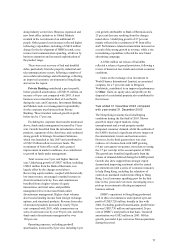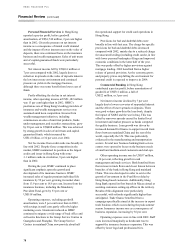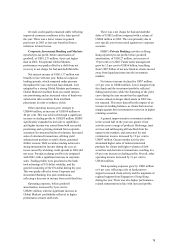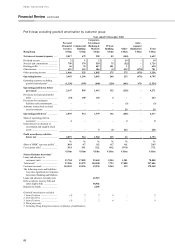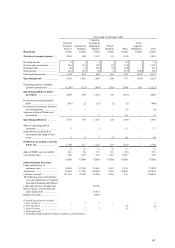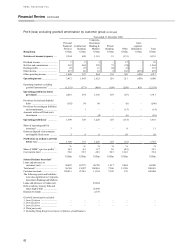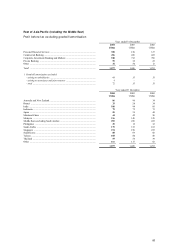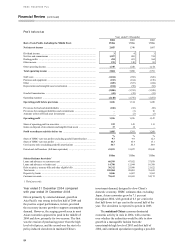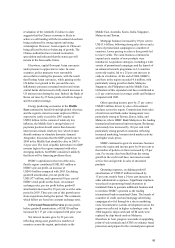HSBC 2004 Annual Report Download - page 77
Download and view the complete annual report
Please find page 77 of the 2004 HSBC annual report below. You can navigate through the pages in the report by either clicking on the pages listed below, or by using the keyword search tool below to find specific information within the annual report.75
HSBC maintained its position as the largest
credit card issuer in Hong Kong. An attractive
rewards programme, successful cross-sales to both
existing and new customers, and customer
acquisition, helped grow the number of cards in
circulation by 14 per cent to 3.5 million. Cardholder
spending increased by 32 per cent compared with
2003, reflecting the successful promotion of credit
card internet bill payment services, and promotional
campaigns launched in conjunction with retail
merchants. Average credit card balances grew by
11 per cent against a backdrop of an overall
reduction in outstanding balances in the market. Fee
income from credit cards rose by 12 per cent
compared with 2003.
Other operating income increased by 24 per cent
to US$1,466 million, largely driven by the continued
strong performance from the insurance and
investment businesses.
During the year, strong emphasis was placed on
growing the insurance business. A series of
promotional campaigns was launched, and the
number of financial planning managers was
increased by 24 per cent to 742. The insurance
product range was also enhanced as new products
designed to meet customers’ needs were introduced.
In 2004, HSBC recorded growth of 40 per cent in
new regular premium life sales, driven by the
success of flexible products tailored to customers’
specific needs, such as the Target Protection Plus
product. Income from the insurance business,
including the Mandatory Provident Fund also grew
by 31 per cent to US$441 million.
Income from sales of unit trusts and structured
products grew by 43 per cent to US$183 million,
reflecting the successful deployment of customer
relationship management systems, an increase in the
number of HSBC Premier relationship managers,
and a rise in stock market activity. New products,
including a range of structured treasury products,
capital-guaranteed funds, open-ended funds and
certificates of deposit, were launched to broaden the
range of investment options. Overall, sales of unit
trusts and structured products grew by
US$609 million, or 9 per cent, compared with 2003.
Higher fee income also came from stockbroking
and custody services, which grew by 49 per cent to
US$185 million, reflecting increased levels of stock
market activity and IPO-related services. Sixty eight
per cent of all securities transactions were processed
on-line in 2004, 5 percentage points higher than in
2003.
Operating expenses, excluding goodwill
amortisation, were 4 per cent higher than in 2003.
Performance-related staff costs increased in line with
sales of investment and insurance products and the
general improvement in profits. Excluding the
impact of incentive payments, staff costs fell by
5 per cent, reflecting greater operational efficiencies
and higher utilisation of the Group Service Centres.
The various income growth initiatives also involved
higher marketing costs, particularly for credit cards,
insurance and investment products.
Credit conditions improved markedly as the
economy recovered, with falling unemployment,
lower bankruptcies, higher residential property
prices and stronger GDP growth. The charge for bad
and doubtful debts fell by US$312 million to
US$54 million. New specific provisions declined by
over 74 per cent to US$95 million, as provisions for
credit card, mortgage and unsecured personal
lending portfolios all fell. There was also a
US$41 million release of general provisions
following a review of historical loss experience and
the improved market environment, in particular a
reduction in mortgage loans with negative equity.
Pre-tax profits, before goodwill amortisation, in
Commercial Banking rose by 29 per cent to
US$914 million, driven by a 14 per cent rise in
operating income and significant releases and
recoveries in provisions.
Operating income benefited from the success of
a series of initiatives designed to enhance the service
offered to middle market customers. The
introduction of a greater number of experienced
relationship managers to service key accounts
contributed significantly to income growth, while a
number of dedicated business development
relationship managers were appointed to focus on
new customers, leading to a 3 per cent increase in
customer numbers. Small and medium-sized
enterprises (‘SME’ s) benefited from the opening of
five new business banking centres offering a
comprehensive range of bespoke services, while an
SME start-up marketing campaign, launched in
October, promoted these services with specific
reference to the BusinessVantage all-in-one account.
These initiatives, together with call centre expansion,
contributed to an increase in income arising from
SME business.
Net interest income increased by 13 per cent as
strong growth in both lending balances and customer
deposits reflected the impact of the relationship
managers and business banking centres. Spreads on
deposits narrowed during the year in the continued
low interest rate environment.
Other operating income rose by 16 per cent to
US$525 million due largely to a significant rise in














